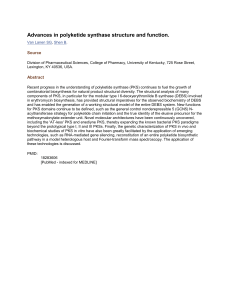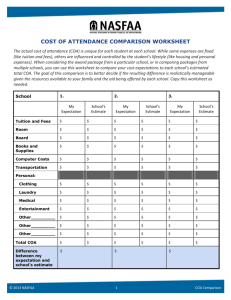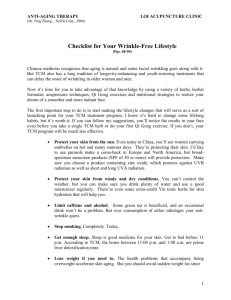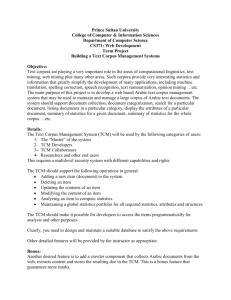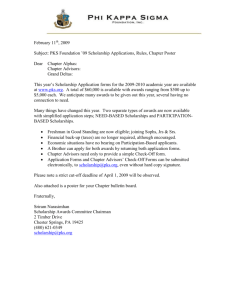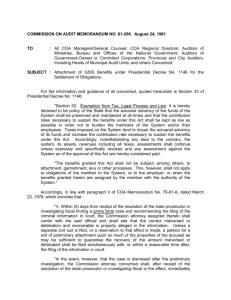Bacterial Enzymatic Synthesis Polyketide
advertisement
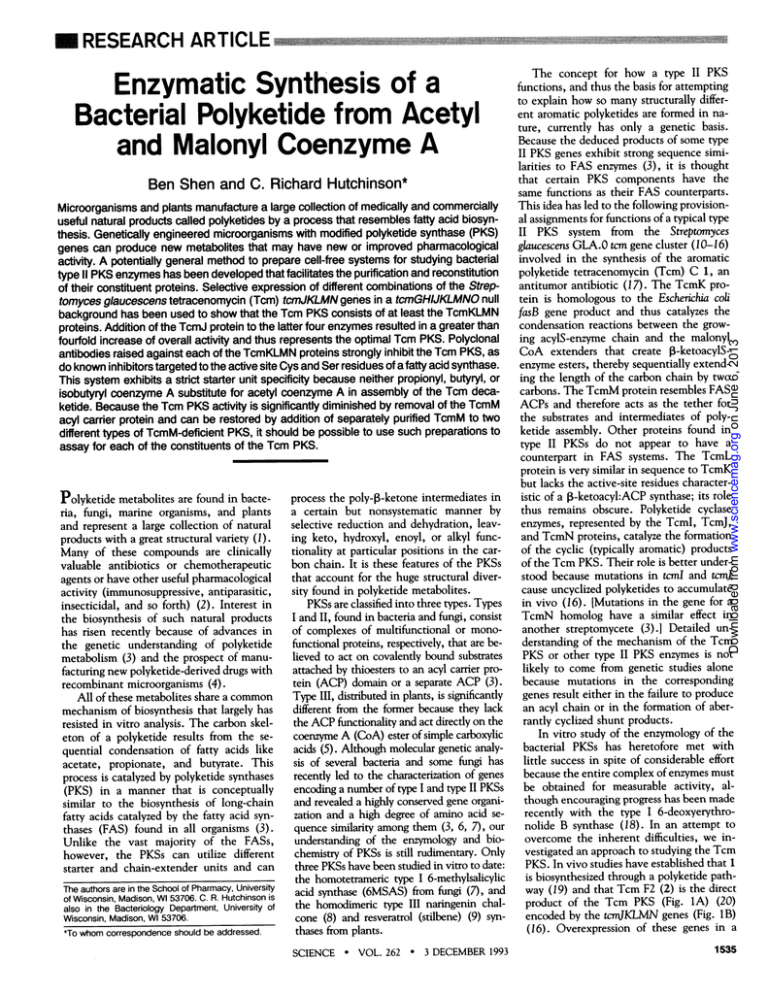
RESEARCH ARTICLE. and Malonyl Coenzyme A Ben Shen and C. Richard Hutchinson* Microorganisms and plants manufacture a large collection of medically and commercially useful natural products called polyketides by a process that resembles fatty acid biosynthesis. Genetically engineered microorganisms with modified polyketide synthase (PKS) genes can produce new metabolites that may have new or improved pharmacological activity. A potentially general method to prepare cell-free systems for studying bacterial type 11 PKS enzymes has been developed that facilitates the purification and reconstitution of their constituent proteins. Selective expression of different combinations of the Streptomyces glaucescens tetracenomycin (Tcm) tcmJKLMN genes in a tcmGHIJKLMNO null background has been used to show that the Tcm PKS consists of at least the TcmKLMN proteins. Addition of the TcmJ protein to the latter four enzymes resulted in a greater than fourfold increase of overall activity and thus represents the optimal Tcm PKS. Polyclonal antibodies raised against each of the TcmKLMN proteins strongly inhibit the Tcm PKS, as do known inhibitors targeted to the active site Cys and Ser residues of a fatty acid synthase. This system exhibits a strict starter unit specificity because neither propionyl, butyryl, or isobutyryl coenzyme A substitute for acetyl coenzyme A in assembly of the Tcm decaketide. Because the Tcm PKS activity is significantly diminished by removal of the TcmM acyl carrier protein and can be restored by addition of separately purified TcmM to two different types of TcmM-deficient PKS, it should be possible to use such preparations to assay for each of the constituents of the Tcm PKS. Polyketide metabolites are found in bacteria, fungi, marine organisms, and plants and represent a large collection of natural products with a great structural variety (1). Many of these compounds are clinically valuable antibiotics or chemotherapeutic agents or have other useful pharmacological activity (immunosuppressive, antiparasitic, insecticidal, and so forth) (2). Interest in the biosynthesis of such natural products has risen recently because of advances in the genetic understanding of polyketide metabolism (3) and the prospect of manufacturing new polyketide-derived drugs with recombinant microorganisms (4). All of these metabolites share a common mechanism of biosynthesis that largely has resisted in vitro analysis. The carbon skeleton of a polyketide results from the sequential condensation of fatty acids like acetate, propionate, and butyrate. This process is catalyzed by polyketide synthases (PKS) in a manner that is conceptually similar to the biosynthesis of long-chain fatty acids catalyzed by the fatty acid synthases (FAS) found in all organisms (3). Unlike the vast majority of the FASs, however, the PKSs can utilize different starter and chain-extender units and can The authors are in the School of Pharmacy, University of Wisconsin, Madison, Wl 53706. C. R. Hutchinson is also in the Bacteriology Department, University of Wisconsin, Madison, WI 53706. *To whom correspondence should be addressed. the poly-,-ketone intermediates in manner by selective reduction and dehydration, leaving keto, hydroxyl, enoyl, or alkyl functionality at particular positions in the carbon chain. It is these features of the PKSs that account for the huge structural diversity found in polyketide metabolites. PKSs are classified into three types. Types I and II, found in bacteria and fungi, consist of complexes of multifunctional or monofunctional proteins, respectively, that are believed to act on covalently bound substrates attached by thioesters to an acyl carrier protein (ACP) domain or a separate ACP (3). Type III, distributed in plants, is significantly different from the former because they lack the ACP functionality and act directly on the coenzyme A (CoA) ester of simple carboxylic acids (5). Although molecular genetic analysis of several bacteria and some fungi has recently led to the characterization of genes encoding a number of type I and type II PKSs and revealed a highly conserved gene organization and a high degree of amino acid sequence similarity among them (3, 6, 7), our understanding of the enzymology and biochemistry of PKSs is still rudimentary. Only three PKSs have been studied in vitro to date: the homotetrameric type I 6-methylsalicylic acid synthase (6MSAS) from fungi (7), and the homodimeric type III naringenin chalcone (8) and resveratrol (stilbene) (9) synthases from plants. process a certain but nonsystematic SCIENCE * VOL. 262 * 3 DECEMBER 1993 Downloaded from www.sciencemag.org on June 6, 2013 Enzymatic Synthesis of a Bacterial Polyketide from Acetyl The concept for how a type II PKS functions, and thus the basis for attempting to explain how so many structurally different aromatic polyketides are formed in nature, currently has only a genetic basis. Because the deduced products of some type II PKS genes exhibit strong sequence similarities to FAS enzymes (3), it is thought that certain PKS components have the same functions as their FAS counterparts. This idea has led to the following provisional assignments for functions of a typical type II PKS system from the Streptomyces glaucescens GLA.0 tcm gene cluster (10-16) involved in the synthesis of the aromatic polyketide tetracenomycin (Tcm) C 1, an antitumor antibiotic (17). The TcmK protein is homologous to the Escherichia coli fasB gene product and thus catalyzes the condensation reactions between the growing acylS-enzyme chain and the malonyl CoA extenders that create 3-ketoacylSenzyme esters, thereby sequentially extending the length of the carbon chain by two carbons. The TcmM protein resembles FAS ACPs and therefore acts as the tether for the substrates and intermediates of polyketide assembly. Other proteins found in type II PKSs do not appear to have a counterpart in FAS systems. The TcmL protein is very similar in sequence to TcmK but lacks the active-site residues characteristic of a 0-ketoacyl:ACP synthase; its role thus remains obscure. Polyketide cyclase enzymes, represented by the TcmI, TcmJ, and TcmN proteins, catalyze the formation of the cyclic (typically aromatic) products of the Tcm PKS. Their role is better understood because mutations in tcmI and tcrnJ cause uncyclized polyketides to accumulate in vivo (16). [Mutations in the gene for a TcmN homolog have a similar effect in another streptomycete (3).] Detailed understanding of the mechanism of the Tcm PKS or other type II PKS enzymes is not likely to come from genetic studies alone because mutations in the corresponding genes result either in the failure to produce an acyl chain or in the formation of aberrantly cyclized shunt products. In vitro study of the enzymology of the bacterial PKSs has heretofore met with little success in spite of considerable effort because the entire complex of enzymes must be obtained for measurable activity, although encouraging progress has been made recently with the type I 6-deoxyerythronolide B synthase (18). In an attempt to overcome the inherent difficulties, we investigated an approach to studying the Tcm PKS. In vivo studies have established that 1 is biosynthesized through a polyketide pathway (19) and that Tcm F2 (2) is the direct product of the Tcm PKS (Fig. 1A) (20) encoded by the tcmJKLMN genes (Fig. 1B) (16). Overexpression of these genes in a 1535 tcmGHUJKLMNO genes expressed (13, 14) has allowed us to develop a cell-free preparation of the Tcm PKS and demonstrate the in vitro synthesis of 2, Tcm F1 (3) and Tcm D3 (4) from acetyl CoA and malonyl CoA. With this cell-free system, we have partially characterized the biochemical properties of the Tcm PKS, explored aspects of the mechanism of a type II PKS, and demonstrated the potential to reconstitute a functional type II PKS in vitro from its constituent proteins. Tcm PKS catalyzes the in vitro synthesis of Tcm F2 from acetyl and malonyl CoA. Because genetic analysis suggested that the Tcm PKS consists of a complex of four to six separate proteins, we decided that instead of attempting to purify the intact complex [this complex is readily dissociated into its discrete constituents by standard chromatographic methods (21)], we would first establish a cell-free system that could synthesize 2. Preparation of the Tcm PKS from the S. glaucescens GLA.0 wild-type strain or the tcmHI mutant that accumulates 2 (16) failed, probably because of the low concentration or transient existence or both of the PKS during the cell growth cycle (Table 1, entries 1 and 2). We then directed our efforts to recombinant S. glaucescens strains, in which the tcm PKS genes are overexpressed (15, 16, 22). As summarized in Table 1, cell-free preparations from S. glaucescens WMH 1068 and S. glaucescens WMH1077, nonproducing strains with a tcmL deletion mutation or a point mutation in the promoter region of the tcmGHUKLMNO operon, respectively, show no Tcm PKS activity as measured by the formation of solvent-extractable materials (entries 3 and 4). In contrast, 2 is synthesized efficiently from acetyl CoA and malonyl CoA in a cell-free preparation from the S. glaucescens WMH1077(pWHM722) transformant that carries the tcmKLMN genes under the control of a strong constitutive promoter in the highcopy-number vector pIJ486 (entries 5 versus 8). Removal of the tcmN gene from pWHM722 (as pELE37, entry 6) results in total loss of the Tcm PKS activity. Addition of the tcmJ gene to pWHM722 (as pWHM732, entry 11) enhances the activity more than fourfold. These results unambiguously confirm our earlier predictions (11, 15, 16) based on sequence comparisons that the tcmKLM genes are responsible for the synthesis of the nascent, enzymebound linear decaketide that is subsequently folded and cyclized by the TcmN protein alone (15) or in combination with the tcmJ gene product (16) to yield 2. [We believe from recent in vivo studies (16) that the TcmN protein is more likely a second polyketide cyclase that recognizes the compound cyclized by TcmJ, although the disare not 1536 tinction between the roles of the two enis not absolutely clear and each of zymes them may be able to perform the other's role to some extent.] These conclusions are supported by the following data. Cell-free preparations made from the S. glaucescens WMH1077(pWHM73 1) transformant, in which the tcmJ gene replaces the tcmN gene in pWHM722, display <10 percent of the Tcm PKS activity than that due to pWHM722 (entries 8 versus 9) and produce at least six possibly cyclic aromatic compounds, including -30 percent of 2 (Fig. 2D). The complex pattern of products observed strongly suggests that the TcmJ enzyme, in the absence of TcmN, does not catalyze the regiospecific cyclization of the decaketide substrate, which presumably is linear or at most monocyclic, and consequently different enzymatic or spontaneous cyclizations, or both, ensue. A similar phe- is observed with the S. glaucescens WMH1077(pWHM726) transformant (data not shown) where the tcmJ gene is added to a cassette of four genes (pWHM721) in which only the first 177 codons of the tcmN nomenon gene are present (entries 7 10). We versus have previously established that TcmN is a multifunctional enzyme and that a portion with codons 1 to 177 of its amino-terminal domain (TcmN177) is sufficient to confer the cyclase activity in vivo (15). However, addition of the TcmN177 to either pELE37 (as pWHM721, entry 7) or pWHM731 (as pWHM726, entry 10) results in very little gain of Tcm PKS activity, indicating that the truncated TcmN177 is unstable or poorly functional in vitro. The presence of all of the =rcJKLMN genes as pWHM732 gives the highest in vitro Tcm PKS activity (entry 11), suggesting that the five proteins produced by these genes represent the optimal Tcm PKS in the WMH1077 background. U A Acetyl CoA HOHO2 O Ha MalonylCO + 9 HR MalonylICoAOH OHOO OH COcHCH OH CH3 OH CH3 OH O 3 4 OH B CH3 LD: KYZi E> 1 1k 1 Fig. 1. (A) Biosynthetic pathway with steps catalyzed by (a) Tcm PKS [Tcm(J)KLMN], (b) Tcm F2 cyclase [Tcmi], (c) Tcm F1 monooxygenase [TcmH], and (d) the four TcmGNOP enzymes. (B) Organization of the cluster of tcm genes for the production of 1 in S. glaucescens (14-24). The wedges indicate the relative size and direction of transcription of the 10 biosynthetic and 2 (tcrnAR) self-resistance genes. Table 1. In vitro synthesis of 2 from acetyl CoA and malonyl CoA (34). Entry Entry S.9.~~fS glaucescens strains tan (source) GLA.0 (17) WMH1092 (16) WMH1068 (15) WMH1077 (14) 1 2 3 4 5 6 7 8 9 10 11 12 13 WMH1077(plJ486) (15) WMH1077(pELE37) (22) WMH1077(pWHM721) (15) WMH1077(pWHM722) (15) WMH1-077(pWHM731) (16) WMH1077(pWHM726) (16) WMH1077(pWHM732) (16) WMH1077(pWHM781) (25) WMH1077(pWHM781)+ WMH1077(pELE37) Genotype Wild type tcmHl mutant AtcmL mutant Promoter mutant Vector tcmKLM tcmKLMMN77 tcmKLMN tcmJKLM tcmJKLMN177 tcmJKLMN tcmKMN tcmKMN Relative activity* (%) Downloaded from www.sciencemag.org on June 6, 2013 strain in which the <2 <1 0 0 0 0 <5 100t <10 <15 450 0 >200t tcmKLM CoA 150 (16,000 cpm), 2 mM gM malonyl *The complete assay solution of 500 gi consisted of 50 pM acetyl CoA, DTT, and 0.8 mg of protein in 0.1 M sodium phosphate buffer, pH 7.5. After 30 min preincubation, the assays were initiated by addition of malonyl CoA, incubated at 30°C for 1 hour, and terminated by addition of solid NaH2PO4 to saturation and extraction with ethyl acetate (2 x 250 p1). The ethyl acetate extract was concentrated in vacuo to dryness, redissolved in 60 gi of methanol, and analyzed by HPLC on a Waters Radi-Pak C18 column (Novapak, 4 g~m, 8 x 100 mm). The column was developed with a linear gradient from CH3CN/H20/CH3COOH (80/20/0.1 percent) to CH3CN in 12 min at a flow rate of 2 mI/min with a Waters 484 variable wavelength absorbance detector tThis value represents 18 percent and a Radiomatic Flo-One/Beta A-515 radio-chromatography detector. *The assay contained 0.8 mg of each of the Tcm PKS preparations. formation of 2 from malonyl CoA. SCIENCE * VOL. 262 * 3 DECEMBER 1993 When 12-14C]malonyl CoA was used as a substrate and the products were subjected to high-performance liquid chromatography (HPLC) and radiochromatographic analysis (Fig. 2), the negative control gives no 2 (retention time tr = 5.5 min) as evident on both the ultraviolet (UV) and 14C chromatograms (Fig. 2A), whereas 2 is the major UV-absorbing product observed from the enzymatic reaction catalyzed by the cell-free preparation from S. glaucescens WMH1077(pWHM722) and is specifically enriched by 14C (Fig. 2E). To authenticate the formation of 2, we coupled the Tcm PKS assay with the Tcm F2 cyclase (23) and Tcm Fl monooxygenase (24) enzymes, both of which we previously purified and characterized from the S. glaucescens WMH1068 strain. Tcm F2 cyclase catalyzes the specific conversion of 2 to 3 and 9-de- 1L ..A . carboxy Tcm F1, 5 (23); addition of this enzyme to the Tcm PKS preparation results in the complete conversion of 2 to 3 (tr = 7.4 min) and 5 (tr = 9.1 min) (Fig. 2F), confirming the in vitro synthesized product as 2. Although 3 and 4 have the same tr under the given HPLC conditions, the former has no UV absorption at 490 nm (20), unlike 4. Tcm F1 monooxygenase catalyzes the specific conversion of 3 to 4 (24) and, as expected, addition of both Tcm F2 cyclase and Tcm F1 monooxygenase to the Tcm PKS preparation causes total conversion of 2 to 4 (tr = 7.4 min) (Fig. 2G). The specific conversions of 2 to 3 and thence 4, and the association of the 14C radioactivity with these three Tcm metabolites clearly establishes their in vitro synthesis from acetyl CoA and malonyl CoA. The fact that Tcm PKS activity is found only in the recombinant strains [such as WMH1O77(pWHM722) or WMH1077(pWHM732)] and is barely detectable in the wild-type or WMH1092 strains demonstrates the effectiveness of the present approach. Overexpression of tcvnJKLMN in a tcmGHUKLMNO null background signifi- Because it is quite difficult to characterize the chemical structure of 2 synthesized in vitro by conventional means because of its instability, we converted 2 in situ to 3 and 4 by highly specific enzymatic reactions. [We have previously reported the enzymatic conversion of 2 to 3 and 4 (20).] o p. - 3500 D cantly enhances the production of the Tcm PKS proteins and provides a defined background for studying the contribution of individual constituents such as TcmJ and TcmN to the PKS activity. This approach has its limitations, however. Although we interpret the observed Tcm PKS activity as the result of the collective overexpression of the tcm genes carried by the plasmid, we cannot rule out other contributions from the host strain. For example, as discussed below, we believe a malonyl CoA:ACP transacylase is essential for the Tcm PKS activity and is provided by the host strain's fatty acid biosynthesis machinery (25). Inhibition of the Tcm PKS by polyclonal antibodies and FAS inhibitors. Polyclonal antibodies raised in rabbits against purified TcmM (21) and TcmN (15) and synthetic short oligopeptides of TcmK and TcmL (22) are monospecific as judged by protein immunoblot analysis (15, 21, 22). All four types of antibodies tested specifically inhibit Tcm PKS activity (Table 2). These inhibitory effects must have resulted from selective removal of the particular constituent from the Tcm PKS enzyme complex or inhibition of its function in the complex, thereby reinforcing the idea that the TcmKLMN proteins are essential for an active Tcm PKS. Type II PKSs exhibit a very high amino acid sequence conservation with the 0-ketoacyl:ACP synthase and ACP constituents of FAS's, particularly around the active sites (3). Specific amino acid residues in the active site motif of FASs can be selectively modified (26) by compounds that are also potent inhibitors of 6MSAS (7) and the plant PKSs (8, 9). As summarized in Table 2, the Tcm PKS is specifically inhibited by .Tcm F2 Table 2. Inhibition of Tcm PKS by polyclonal antibodies and by FAS inhibitors. 0 7000 selCmaitm Downloaded from www.sciencemag.org on June 6, 2013 ------- Tcm F2 E 0 Addition Entry 7000] F 7000 'W at 490 nm () (%) fTcm Fl 1 2 3 4 5 6 Tcm D3 G 5.0 Relative activity* 10.0 Time (min) 7 8 9 10 11 lOOt None Anti-TcmKt Anti-TcmLf Anti-TcmM* Anti-TcmNil -DTT -DTT + -DTT + -DTT + -DTT + -DTT + cerulenin§ N-ethylmaleimidell 41 44 24 36 97 0 0 0 0 25 pCMBAI" iodoacetamidell PMSF" *The complete assay solution of 500 p1 consisted of 50 p.M acetyl CoA, 150 p.M malonyl CoA (16,000 cpm), 2 Fig. 2. HPLC analysis with UV absorbance and 14C-radioactive detection of the in vitro synthesis of 2 from acetyl CoA and malonyl CoA and its conversion to 3 and 4 in the presence of a Tcm PKS preparation from: (A) S. glaucescensWMH1077(plJ486) and [2-14C]malonyl CoA (16,000 cpm); (B) S. glaucescens WMH1077(pWHM722) and [1-14C]acetyl CoA (65,000 cpm); (C) S. glaucescens WMH1077(pWHM722), [1-14C]acetyl CoA (65,000 cpm), and Tcm F2 cyclase (7 jig); (D) S. glaucescens WMH1077(pWHM731), and [2-14C]malonyl CoA (16,000 cpm); (E) S. glaucescens WMH1077(pWHM722) and [2-14C]malonyl CoA (16,000 cpm); (F) S. glaucescens WMH1077(pWHM722), [2-14C]malonyl CoA (16,000 cpm), and Tcm F2 cyclase (7 ,ug); and (G) S. glaucescensWMH1077(pWHM722), [2-14C]malonyl CoA (16,000 cpm), Tcm F2 cyclase (7,g), and Tcm F1 monooxygenase (10 [Lg). mM DTT, 0.8 mg of the Tcm PKS from S. glaucescens WMH1077(pWHM722), and the indicated amount of SCIENCE * VOL. 262 * 3 DECEMBER 1993 1537 antibodies or inhibitors in 0.1 M sodium phosphate buffer, pH 7.5. The assays were performed and analyzed as described in the footnote of Table 1. tThis value represents 14 percent formation of 2 from malonyl CoA. $40 p]. §50 pm. 11200 pm. 1538 high substrate specificity and structurally related CoA esters are used less than 1/10 as effectively as the natural starter 4coumaroyl CoA (9). Animal FASs are generally able to use long-chain (up to four carbons), unbranched acyl CoAs as starter units in vitro, often more effectively than acetyl CoA (30). Bacterial FASs, in contrast, appear to be quite substrate specific: Those from organisms whose lipids contain predominantly straight-chain fatty acids show diminished activity with increased chain length of the starter unit, whereas those from organisms containing branched fatty acids as their major cellular species use long-chain acyl CoA esters such as butyryl CoA or a-keto-o-methyl butyryl CoA as starter units much more effectively than acetyl CoA (30). To examine if the Tcm PKS is able to use starter units other than acetyl CoA, 14C-labeled propionyl CoA, butyryl CoA, and isobutyryl CoA esters were prepared (31) and examined as substrates. With unlabeled malonyl CoA as the extender, any 14C-enriched product HO-Sw- must result from the incorporation of one of these 14C-labeled starter units (32). Although we do not have authentic samples of Tcm F2 analogs in which any of these potential starter units has been incorporated, such compounds should have similar UV absorbance and HPLC behavior as 2. As expected, [1-_4C]acetyl CoA gives [14CJ-2 (Fig. 2B) that is specifically converted to 3 in the presence of Tcm F2 cyclase (Fig. 2C). However, the comparatively low incorporation of radioactivity indicates that the [1-_4Cjacetyl CoA pool is diluted, presumably by acetyl CoA derived from decarboxylation of malonyl CoA (the cellular acetyl CoA is removed during the preparation of the Tcm PKS) that is catalyzed by a malonyl CoA decarboxylase (33). This is demonstrated by using [2-14Clmalonyl CoA as the only substrate: 2 is synthesized as efficiently as with acetyl CoA (data not shown), suggesting that the acetate starter unit is derived from the decarboxylation of malonyl CoA, or possibly malonyl-TcmM by analogy to fatty acid a CH3COSCoA CH3C00I-s.- d 0 HS Cys- b CH2(COOH)COSCoA 0 HS ;Cys- tAcytransferase. SCO2COOH Nc -2 CoA NS HOSwr- r HO-Ser- 0 CH3COS"- HSCys- SCOCH2COOH HO-Sr- f CH3COCH2C0S l Downloaded from www.sciencemag.org on June 6, 2013 cerulenin (entry 7), which inhibits FAS by forming an adduct with the active site Cys residue of the P-ketoacyl:ACP synthase (27). Cerulenin presumably inhibits the Tcm PKS similarly by reacting with the Cys173 residue in the TcmK active site motif: l&4GPVTVVSTGCTSGLDAVGl"l (11, 28). The presence of this Cys'73 also explains the inhibitory effect of sulfhydryl reagents such as p-chloromercuribenzoic acid (pCMBA) and N-ethylmaleimide on Tcm PKS activity (entries 8 and 9). It is believed (26) that in the initial steps of fatty acid synthesis, the 0-ketoacyl:ACP synthase and ACP components of the FAS are primed with acetyl CoA and malonyl CoA, respectively, through reactions catalyzed by acetyl CoA and malonyl CoA transacylases. Genes for such activities have not been found in the tcm gene cluster (14) or in any other set of genes for a type II PKS (3). The ORF305 gene of the S. glaucescens FAS cluster encodes a malonyl CoA transacylase (25), and the enzyme obtained by overexpression of this gene in E. coli transfers malonyl CoA to the S. glaucescens ORF82 FAS ACP as efficiently as to TcmM in vitro (25), suggesting that the Tcm PKS may share this malonyl CoA transacylase with the FAS in the same organism. Although it remains to be established if a separate acetyl CoA transferase is required for the Tcm PKS, an acyl transferase active site motif, 340PVSSIKSMIGHSLGAIH356, is present in TcmK (11, 28) and the Ser35' residue could act as a loading site for acetate, as in a FAS (26). Hence, as in a FAS P-ketoacyl:ACP synthase where the corresponding Ser residue is specifically modified by iodoacetamide or phenylmethylsulfonyl fluoride (PMSF) (26), these reagents also inhibit the Tcm PKS (Table 2, entries 10 and 11). High substrate specificity of Tcm PKS for acetyl CoA as the starter unit. A distinctive feature of PKSs is their ability to choose different starter units for polyketide biosynthesis. For example, acetyl CoA is the starter in the biosynthesis of Tcm C but propionyl CoA and malonamyl CoA apparently are the starters for the biosynthesis of daunorubicin and oxytetracycline in Streptomyces peucetius and Streptomyces rimosus, respectively (3). It is not known how this substrate specificity of a PKS is determined. On the basis of antibiotic isolation work, the S. coeruleorubidus baumycin (daunorubicin) PKS seems to be able to accept acetyl CoA, butyryl CoA, or isobutyryl CoA as starter units, albeit much less efficiently than propionyl CoA (29). Naringenin chalcone synthase (8) uses various aromatic and aliphatic CoA esters as starters, some of which are used as efficiency as 4-coumaroyl CoA, the normal substrate of the enzyme, yet resveratrol (stilbene) synthase displays H- a CH2(COOHCSCoA b 10 CH3COCH2C0S'Cy SCysH a C2. - 8 CoA nQ 2Q -Q .1 HOH, .3 o 0 O CH3 HOH Fig. 3. Model for the Tcm PKS catalyzed synthesis of 2 from acetyl CoA and malonyl CoA. TcmK and TcmM are primed by acetyl CoA and malonyl CoA; the formation of TcmM-SCOCH2C00H in step b presumably is catalyzed by a malonyl CoA:ACP transacylase but it is uncertain if attachment of the acetyl group to the Ser351 in step a requires another transacylase. In step d, the acetyl group is internally transferred to the Cys'73 residue of TcmK, and then condensation between the acetyl and malonyl groups occurs in step e, transferring the acyl group from TcmK to TcmM. [Step c is a possible alternative route to the latter intermediate.] After internal transfer of the acetoacetyl group to TcmK in step f, steps b, e, and f are repeated eight times, using 8 more equivalents of malonyl CoA to produce the linear decaketide attached to TcmM. This decaketide is released hydrolytically and cyclized by TcmN and TcmJ to 2, which involves the loss of 3 equivalents of water. The oval shapes show the relative size of each protein but the stoichiometry is unknown. To distinguish their inability to form solvent-extractable products from the TcmJ and TcmN proteins, TcmKLM are depicted to act as a single complex that forms the Tcm decaketide (shown in the conformation that would form 2 most readily), although we do not have evidence that validates this idea. SCIENCE * VOL. 262 * 3 DECEMBER 1993 m. .. ... W. .... biosynthesis in E. coli (26). No '4C-enriched product that also has UV absorption is observed with [1_t4Clpropionyl CoA, [1-_4Clbutyryl CoA, and [1-4C]isobutyryl CoA as starter units and malonyl CoA as the extender, ruling out the possibility of the synthesis of a Tcm F2-like compound from either of these three starter units. Therefore, the data suggest that the Tcm PKS has a high substrate specificity for acetyl CoA as the starter unit. This result has important implications for attempts to manufacture analogs of such aromatic polyketides by modification of the PKS genes. In vitro reconstitution of the Tcm PKS. Because the intrinsic nature of a type II PKS as an assembly of discrete proteins makes it unwise to attempt to purify the intact PKS, we have decided to purify each of its constituent proteins separately and then to attempt to reconstitute the Tcm PKS in vitro. This approach requires the production and purification of each constituent protein in active form and the knowledge that individual proteins will adopt the correct conformation and complexation state upon reconstitution of the PKS complex. We chose the TcmM ACP to illustrate our strategy because it serves as the substrate for the malonyl CoA:ACP transacylase (21) and, in turn, malonyl-TcmM serves as the substrate for the ,-ketoacyl:ACP synthase. Both of these facts require that TcmM interacts intimately with the rest of the Tcm PKS constituents. We developed two methods to prepare TcmM-deficient PKS systems that contain the remaining constituent proteins and ..M *.* R.E then determined if the Tcm PKS activity is restored by supplemention with purified TcmM (21). As summarized in Table 3, TcmM is removed by immunoprecipitation from an active PKS preparation by its complexation with the TcmM antiserum and removal by affinity chromatography on a protein A column to yield a TcmM-deficient PKS. The resulting preparation displays diminished Tcm PKS activity (entries 1 to 3), reflecting the lack of TcmM. Remarkably, addition of purified TcmM to this TcmM-deficient PKS fully restores the PKS activity (entries 4 and 5) and addition of either the S. glaucescens Orf82 FAS ACP (25) or the E. coli ACP has no effect (entries 6 to 9). Alternatively, a cell-free preparation was made from S. glaucescens WMHL077(pWHM722) by adding (NH4)2S04 to 72 percent saturation instead of the normal 82 percent (34). Because very little TcmM is precipitated at this percent saturation of (NH4)2S04 (21), the resulting preparation will lack TcmM but we assume that the other PKS proteins are precipitated to a great degree under the given conditions. As above, the enzyme activity of the second TcmM-deficient PKS is enhanced more than twofold upon addition of purified TcmM (entries 10 versus 11 and 12) and addition of either the S. glaucescens Orf82 FAS ACP or the E. coli ACP has little or no effect (entries 13 to 16). This work not only demonstrates the feasibility of reconstituting a type II PKS in vitro from its individually purified constituent proteins but also provides a means to Table 3. Effect of ACP on the TcmM-deficient PKS. Relative Entry activity* Assay description * 1 2 3 4 5 6 7 8 9 10 PKS PKS + TcmM antibodies TcmM-deficient PKSt +TcmM: +TcmM§ +Orf82t +0rf82§ +E. coli ACPt +E. coli ACP§ TcmM-deficient PKS11 11 12 13 14 15 16 +TcmMl +TcmM§ +Orf82t ~~~(%) 100 56 53 114 137 46 51 52 44 100 183 206 118 107 120 104 +0rf82§ +E. coliACPt +E. coli ACP§ *The complete assay solution of 500 1d consisted of 50 FM acetyl CoA, 150 p.M malonyl CoA (16,000 cpm), 2 mM DTT, 0.3 mg of protein, and the indicated amount of ACP in 0.1 M sodium phosphate buffer, pH 7.5. The assays tThe Tcm PKS preparation from S. were performed and analyzed as described in the footnote of Table 1. g/aucescensWMH1077(pWHM722) was added to a solution of polyclonal TcmM antibodies and incubated on ice for 30 min. The TcmM immunocomplexes were removed by affinity chromatography on a protein A column to yield §310 t165 ng. a TcmM-deficient PKS. Entry 1 represents 14 percent formation of 2 from malonyl CoA. 9The TcmM-deficient PKS was prepared from S. glaucescens WMH1077(pWHM722) according to the ng. same protocol (34) except that (NH4)2SO4 was added to 72 percent saturation. Entry 10 represents 19 percent formation of 2 from malonyl CoA. SCIENCE * VOL. 262 * 3 DECEMBER 1993 biochemically assay each protein prior to reconstitution. Therefore, we expect that we will be able to use Tcm PKS preparations from S. glaucescens WMH1077 transformed with derivatives of pWHM722 that lack either tcrnJ, tcmK, tcmL, or tcmN to assay in turn for each of these PKS constituents by following the production of 2 in vitro. For example, a 1:1 mixture of Tcm PKS preparations from the WHM1077(pELE37) and - (pWHM781) transformants, both of which are unable to synthesize 2 (Table 1, entries 6 and 12), restores the production of 2 to a level above that of the WMH1077(pWHM722) strain (Table 1, entry 13 versus 8). Protein fractionation shows that this results from the ability of TcmL from pELE37 to interact with TcmKMN in the WMH1O77(pWHM781) extract. We note that TcmM cannot be substituted in vitro by either the S. glaucescens Orf82 or E. coli FAS ACPs despite the fact that all three of these ACPs have a high amino acid sequence similarity in certain regions (3, 25) and are equally active in the in vitro malonyl CoA:ACP assay (25). This result is consistent with our earlier prediction (21) that the overall three-dimensional conformation of TcmM may be different from other ACPs and underscores the ambiguity of assaying the individual biochemical activity of the constituent proteins without considering the interaction among them during the in vitro reconstitution of an active PKS. However, this idea is inconsistent with the fact that Streptomyces coelicolor is able to produce a blue pigment assumed to be actinorhodin plus some of its biosynthetic intermediates, indicative of the formation of a functional hybrid PKS, when its actl ORF3 ACP gene is replaced in cis with other type II PKS ACP genes including tcmM (35). This observation may reflect a difference between the in vivo and in vitro constitution of the PKS enzyme complex, or simply that all these type II PKS ACPs more or less resemble each other conformationally as well as biochemically. Thus, it will be very interesting to determine the effect of supplementing the TcmM-deficient Tcm PKS with other type II PKS ACPs when these become available. Biochemical model for the Tcm PKS. By definition, a PKS refers collectively to the enzymes that catalyze the synthesis of a linear polyketide from short-chain fatty acids. Because the linear polyketide intermediates are extremely reactive and inherently unstable (36), all of the currently identifiable products of a type II PKS are in their cyclized forms. Although the chalcone synthases and 6MSAS catalyze the synthesis of aromatic products, their cyclase domain has not been identified; in contrast, genetic analysis of several type II PKSs has revealed highly conserved genes for a cyclase activity (3). Because our data show that polyketide 1539 Downloaded from www.sciencemag.org on June 6, 2013 :i I.l . A, cyclases like TcmJ and TcmN must play a role in the cyclization of the nascent linear polyketide, such enzymes are a distinctive feature of a given PKS and should be included as part of the optimal PKS complex, at least in the type II system. Consequently, from the information presented here and elsewhere (1 1-16, 21, 22), we propose the following model for the Tcm PKS catalyzed synthesis of 2 from acetyl CoA and malonyl CoA. As shown in Fig. 3, the acetyl CoA and malonyl CoA enter the PKS through TcmK and TcmM, respectively. Although we know that the loading of malonyl CoA onto TcmM can be catalyzed by a malonyl CoA:ACP transacylase that is part of the normal FAS, it remains to be established if this is the sole route to malonylPTcmM (step b). Similarly, we do not know if the entry of acetyl CoA through Ser35' and CysI73 of TcmK requires a separate acetyl CoA:TcmK transacylase (step a), or if TcmK, like the E. coli P-ketoacyl:ACP synthase III (37), can form acetoacetyl-TcmM directly from acetyl CoA and malonyl-TcmM (step c). Regardless of the mechanism of the initial step, the newly formed acetoacetyl chain (step e) is then transferred to TcmK (step f), freeing TcmM to accept the second malonyl CoA extender unit for the next condensation cycle. This three-step process (steps b, e, and f is repeated eight times to yield the decaketide. The results of recent in vivo studies with hybrid type II PKSs (38, 39) suggest that TcmK and particularly TcmL somehow determine the length of the polyketide during this assembly process. Finally, the nascent linear decaketide, possibly still attached to TcmM through a thioester linkage, is folded and cyclized by TcmJ and TcmN to form 2. It is not clear yet when and how the decaketide is released from TcmM; the lack of extractable radioactivity when only the TcmKLM proteins are present suggests that release and cyclization occur simultaneously or at least in tandem. Release prior to cyclization probably would result in formation of multiple, inappropriately cyclized products stemming from the facile reactivity of free polyketides (36) (this may be the reason for the formation of several UV-absorbing compounds by the TcmJKLM proteins in the absence of TcmN). An equivalent event in animal fatty acid biosynthesis is catalyzed by a thioesterase (26), but no such enzyme activity has been identified for chalcone synthase or 6MSAS as well as for a type II PKS. Our data cannot rule out the possibility that a FAS thioesterase is responsible for 1 540 the hydrolysis of the decaketide from TcmM, and it is equally valid to argue that the deca-1-ketothioester-TcmM intermediate could be hydrolyzed spontaneously as has been proposed for 6MSAS (40). REFERENCES AND NOTES 1. D. O'Hagen, The Polyketide Metabolites (Horwood, Chichester, U.K., 1991). 2. R. L. Monaghan and J. S. Tkacz, Annu. Rev. Microbiol. 44, 271 (1990). 3. D. A. Hopwood and D. H. Sherman, Annu. Rev. Genet. 24, 37 (1990); L. Katz and S. Donadio, Annu. Rev. Microbiol. 47, 875 (1993). 4. L. Katz and C. R. Hutchinson, Annu. Rep. Med. Chem. 27, 129 (1992); S. Donadio, J. B. McAlpine, P. J. Sheldon, M. Jackson, L. Katz, Proc. Nati. Acad. Sci. U.S.A. 90, 7119 (1993). 5. K. Hahibrock, in The Biochemistry of Plants, E. E. Conn, Ed. (Academic Press, New York, 1981), pp. 425-456. 6. M. E. Mayorga and W. E. Timberlake, Mol. Gen. Genet. 235, 205 (1992); C. Scotti etal., Gene 130, 65 (1993). 7. P. Dimroth, H. Walter, F. Lynen, Eur. J. Biochem. 13, 98 (1970); J. Beck, S. Ripka, A. Siegner, E. Schiltz, E. Schweizer, ibid. 192, 487 (1990); 1.-K. Wang, C. Reeves, C. M. Gaucher, Can. J. Microbiol. 37, 86 (1991); J. B. Spencer and P. M. Jordan, Biochemistry31, 9107 (1992). 8. F. Kreuzaler and K. Hahibrock, Eur. J. Biochem. 56, 205 (1975); F. Kreuzaler et al., ibid. 99, 89 (1979); R. Schuz, W. Heller, K. Hahibrock, J. Biol. Chem. 258, 6730 (1983); T. Lanz, S. Tropf, F.-J. Marner, J. Schroder, G. Schroder, ibid. 266, 9971 (1991). 9. A. Schoppner and H. Kindi, J. Biol. Chem. 259, 6806 (1984); G. Schroder, J. W. S. Brown, J. Schroder, Eur. J. Biochem. 172,161 (1988). 10. H. Motamedi and C. R. Hutchinson, Proc. Nat!. Acad. Sci. U.S.A. 84, 4445 (1987). 11. M. J. Bibb, S. Biro, H. Motamedi, J. F. Collins, C. R. Hutchinson, EMBO J. 8, 2727 (1989). 12. P. G. Guilfoile and C. R. Hutchinson, J. Bacteriol. 174, 3651 (1992). 13. H. Decker, H. Motamedi, C. R. Hutchinson, ibid. 175, 3876 (1993). 14. H. Decker and C R. Hutchinson, ibid., p. 3887. 15. R. G. Summers, E. Wendt-Pienkowski, H. Motamedi, C. R. Hutchinson, J. Bacteriol. 174, 1810 (1992). ibid., in press. 16. 17. W. Weber, H. Zahner, J. Siebers, K. Schroder, A. Zeeck, Arch. Microbiol. 121, 111 (1979). 18. P. Caffrey, D. J. Bevitt, J. Staunton, P. F. Leadlay, FEBS Lett. 304, 225 (1992); G. A. Roberts, J. Staunton, P. F. Leadlay, Eur. J. Biochem. 214,305 (1993). 19. J. Siebers, thesis, University of Gottingen, Germany (1979). 20. B. Shen, H. Nakayama, C. R. Hutchinson, J. Nat. Prod. 56, 1288 (1993). 21. B. Shen, R. G. Summers, H. Gramajo, M. J. Bibb, C. R. Hutchinson, J. Bacteriol. 174, 3818 (1992). 22. H. Gramajo, J. White, C. R. Hutchinson, M. J. Bibb, ibid. 173, 6475 (1991). 23. B. Shen and C. R. Hutchinson, Biochemistry 32, 11149 (1993). 24. _ , ibid. 32, 6656 (1993). 25. C. R. Hutchinson et al., in Industrial Microorganisms: Basic and Applied Molecular Genetics, R. H. Baltz, G. D. Hegeman, P. L. Skatrud, Eds. (American Society for Microbiology, Washington, DC, 1993), pp. 203-216; A. Ali, R. G. Summers, B. Shen, W. Wessel, C. R. Hutchinson, unpublished data. 26. S. J. Wakil, Biochemistry 28, 4523 (1989); K. SCIENCE * VOL. 262 * 3 DECEMBER 1993 27. 28. 29. 30. 31. 32. 33. Magnuson, S. Jackowski, C. 0. Rock, J. E. Cronan Jr., Microbiol. Rev. 57, 522 (1993). S. Omura, Methods. Enzymol. 72, 520 (1981). Abbreviations for the amino acid residues are: A, Ala; C, Cys; D, Asp; E, Glu; F, Phe; G, Gly; H, His; I, lie; K, Lys; L, Leu; M, Met; N, Asn; P, Pro; 0, Gin; R, Arg; S, Ser; T, Thr; V, Val; W, Trp; and Y, Tyr. T. Oki etal., J. Antibiot. 34, 783 (1981); A. Yoshimoto et al., ibid. 46, 56 (1993). A. W. Alberts and M. D. Greenspan, in Fatty Acid Metabolism and Its Regulation, S. Numa, Ed. (Elsevier, New York, 1984), pp. 29-58; N. Singh and J. K. Stoops, in Enzyme Mechanisms, M. I. Page and A. Williams, Eds. (Royal Society of Chemistry, London, 1987), pp. 534-550. A. Kawaguchi, T. Yoshimura, S. Okuda, J. Biol. Chem. 89, 337 (1981). The complete assay solution of 500 0I consisted of 500 gM malonyl CoA, 2 mM dithiothreitol (DTT), 3.2 mg of the Tcm PKS from S. glaucescens WMH1077(pWHM722), and 100 gM [1-14C]acyl CoA (65,000 cpm for acetyl CoA, 1 16,000 cpm for propionyl CoA, 45,000 cpm for butyryl CoA, and 73,000 cpm for isobutyryl CoA) in 0.1 M sodium phosphate buffer, pH 7.5. The assays were performed and analyzed as described in the footnote of Table 1. F. Kreuzaler, R. J. Light, K. Hahlbrock, FEBS Lett. 94,175 (1978); Y. S. Kim and P. E. Kolattukudy, J. Biol. Chem. 255, 686 (1980); A. R. Hunaiti and P. E. Kolattukudy, Arch. Biochem. Biophys. 229,426 (1984). Downloaded from www.sciencemag.org on June 6, 2013 - 34. Cultures of wild-type or recombinant S. glaucescens strains were grown on R2YENG medium (10), supplemented with thiostrepton (10 lg/ml) when necessary, at 300C and 300 rpm for 28 hours, harvested by centrifugation (13,600g, 20 min, 4°C), and washed sequentially with 0.5 M NaCI and 0.1 M sodium phosphate buffer, pH 7.2. Cells (1 g/10 ml) were lysed in sodium phosphate buffer (pH 7.2)-2 mM DTT0.1 mM PMSF-1 mM EDTA-10 percent glycerol with lysozyme (1 mg/mI) at room temperature for 2 hours and deoxyribonuclease (1 pg/ml) and MgCI2 (5 mg/mI) were added and incubated on ice for an additional hour. Centrifugation (27,500g, 20 minm 4°C) yielded a clear supernatant that was further brought to 82 percent saturation of (NH4)2SO4 and centrifuged as above to collect the pellet. This pellet was dissolved in a minimum volume of 0.1 M sodium phosphate buffer (pH 7.2)-2 mM DTT-1 mM EDTA-1 0 percent glycerol and desalted on a Sephadex G-25 column to yield the Tcm PKS preparation (15 to 20 mg/mI proteins). 35. C. Khosla, S. Ebert-Khosla, D. A. Hopwood, Mol. Microbiol. 6, 3237 (1992); C. Khosla et al., J. Bacteriol. 175, 2197 (1993). 36. T. M. Harris and C. M. Harris, Pure Appl. Chem. 58, 283 (1986). 37. J.-T. Tsay, W. Oh, R. J. Larson, S. Jackowski, C. 0. Rock, J. Biol. Chem. 267, 6807 (1992). 38. R. G. Summers, E. Wendt-Pienkowski, C. R. Hutchinson, unpublished work. 39. R. McDaniel, S. Ebert-Khosla, D. A. Hopwood, C. Khosla, Science 262, 1546 (1993). 40. J. B. Spencer and P. M. Jordan, Biochem. J. 288, 839 (1992). 41. We thank R. Summers and E. Wendt-Pienkowski for the pWHM plasmids and recombinant strains, and useful discussions; M. Bibb, H. Gramajo, and J. White for pELE37 and the TcmK and TcmL antisera; C. Khosla for communication of results prior to publication; and L. Katz and R. Losick for critical reading of the manuscript. Supported by a grant from the National Institutes of Health (CA35381). 21 June 1993; accepted 12 October 1993
